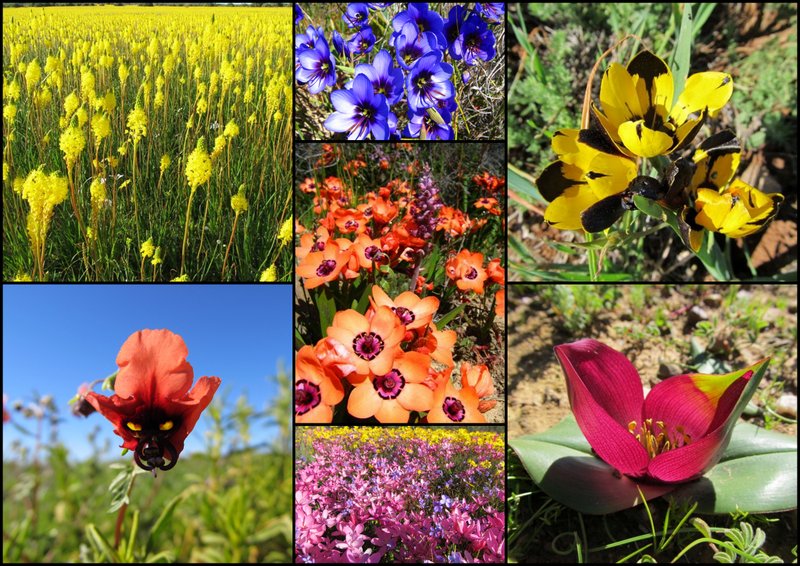The Treasure
Nieuwoudtville’s treasures
The Khoi San inhabited this area for many centuries before the first settlers arrived in about 1730, and local rock art in Oorlogskloof Nature Reserve and on farms around Nieuwoudtville bears witness to an ancient culture that flourished here. During this period vast herds of game periodically roamed the plains of the Bokkeveld Plateau (Antelope Plateau), after which it derived its name.
In the late 1700s wild herds had been replaced by large herdsof sheep and cattle belonging to the settlers. The early settlers established themselvesclose to the present town of Nieuwoudtville at Groenrivier and Willemsrivier, where the first formal church building still stands.
Local Sandstone
The settlers favoured the western part of the plateau for their homesteads and farmyards because the large flat sandstone areas provided well-drained surfaces in the wet winters when the remaining countryside was too soggy for wagons and livestock. An added attraction was the convenient line of reliable springs surfacing at the edge of the sandstone that provided water in the dry summer months.
The sandstone was also good material for building and some of the farm buildings made from sandstone block are still proudly standing after more than 200 years. When the town of Nieuwoudtville was founded in 1897, on land that was purchased from H.C. Nieuwoudt after whom the town is named, the fine old buildings were fashioned from the same local rock.
In more recent times Nieuwoudtville has become a ‘Mecca’ for botanists and flower lovers from around the world, and visitors’ books boast an impressive number of “pilgrims” from far and wide.
Our Environment
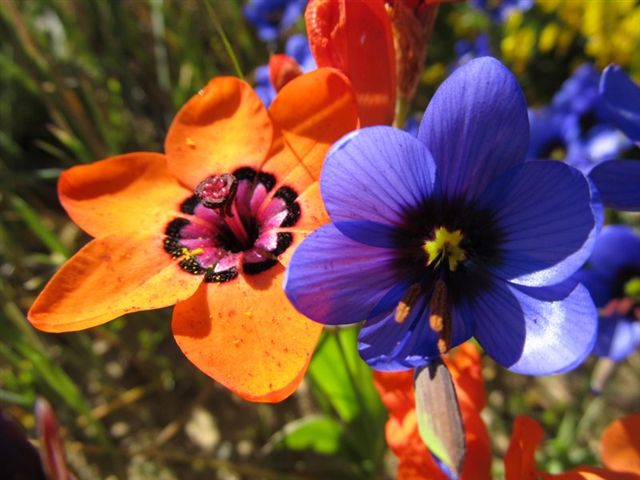 The great diversity of flowers, and particularly geophytes, that occur on the Bokkeveld is what makes Nieuwoudtville both special and different from the rest of Namaqualand.
The great diversity of flowers, and particularly geophytes, that occur on the Bokkeveld is what makes Nieuwoudtville both special and different from the rest of Namaqualand.
The diversity of geophytes is particularly astounding. The area a round Nieuwoudtville has 309 species of geophyte. To put this in perspective, there are about 1551 geophytes in the entire Cape flora and this is 4-5 times richer than other Mediterranean regions such as California, Western Australia, and the Mediterranean basin. In good rainfall years the display of spring annuals around Nieuwoudtville transforms the landscape into a picture of colour, and when these have set seed there are still many interesting flowers to be found long after the first flush of spring.
round Nieuwoudtville has 309 species of geophyte. To put this in perspective, there are about 1551 geophytes in the entire Cape flora and this is 4-5 times richer than other Mediterranean regions such as California, Western Australia, and the Mediterranean basin. In good rainfall years the display of spring annuals around Nieuwoudtville transforms the landscape into a picture of colour, and when these have set seed there are still many interesting flowers to be found long after the first flush of spring.
To get the most out of the Bokkeveld, you must take your time, don’t rush along. It is not uncommon to find up to 50 different species within one square metre of Renosterveld!
Dolerite Koppies
The north-south row of dolerite koppies to the east of Nieuwoudtville are the remains of a dolerite sill. Dolerite sills and dykes are intrusions of igneous rock formed by molten magma from the Earth’s mantle that forced its way to the surface through cracks in the rock layers. Cracks may form when there is tension in the Earth’s surface, e.g. the break-up of Gondwanaland. Dykes are vertical (or nearly vertical) intrusions of magma cutting across sedimentary layers. Sills form when the magma is able to force itself between sedimentary layers. In other words they are parallel to the layers. The dolerite is more resistant to weathering and erosion than the surrounding sedimentary rocks so the dolerite stands out from the surrounding landscape as a row of koppies. The large boulders that are typical of these koppies were formed when the magma cooled relatively quickly forming cracks and columns of rock. With time, weathering has produced the spectacular balancing rocks so evident in the koppies.
Glacial Pavement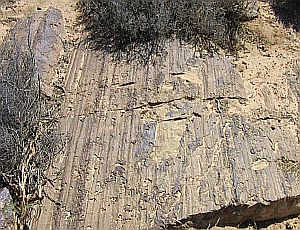
Evidence of the extensive sheet glacier that covered much of South Africa about 300 million years ago can be seen south of Nieuwoudtville where grooves formed by rocks and pebbles carried in the ice sheet were left behind on the glacial floor after the ice sheet melted. These glacial pavements tend to impede water infiltration and damp patches result, which are favourite habitats for some of the lovely local geophytic plants.
Nieuwoudtville Underground
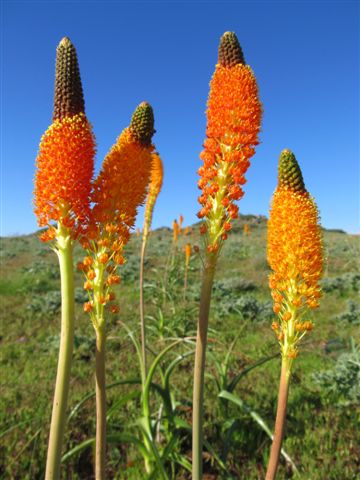 Nieuwoudtville is renowned for its high number of bulbous plants. The variety of flowers is immediately obvious, but there is an equally amazing diversity of below ground structures. Plants that can store reserves underground, where they won’t dry out, and that have a dormant period during the hottest months when they don’t have leaves or stems above ground, are well suited to survive the summer droughts that occur in Nieuwoudtville.
Nieuwoudtville is renowned for its high number of bulbous plants. The variety of flowers is immediately obvious, but there is an equally amazing diversity of below ground structures. Plants that can store reserves underground, where they won’t dry out, and that have a dormant period during the hottest months when they don’t have leaves or stems above ground, are well suited to survive the summer droughts that occur in Nieuwoudtville.
Botanists refer to these plants as geophytes and the below ground structures may be classified as bulbs, corms, rhizomes, or tubers.
In some areas around Nieuwoudtville there may be as many as 25 000 geoph ytes per square metre, but it is more usual to find a few hundred plants. At this density, a spadefull of soil will contain more than 100 bulbs and corms.
ytes per square metre, but it is more usual to find a few hundred plants. At this density, a spadefull of soil will contain more than 100 bulbs and corms.
Part of the reason for this abundance seems to be the different ways in which these plants survive the combined effects of drying out and being eaten. An underground bulb or corm may escape the hot sun but it also provides a potential meal for porcupines and mole rats. A single porcupine could eat several hundred bulbs a night so surviving being eaten can be as important as escaping desiccation.
Some geophytes have shallow bulbs with low nutritional value and a high water content.
Some of these bulbs may reach the size of a football (e.g. Boophone). Others have small corms or bulbs that are buried deep in the soil (e.g. Wurmbea), reaching into the rocky layer where they are well protected. Still others are designed to break up when they are disturbed, so the primary bulb or corm is surrounded by numerous bulbils or cormlets.
There are also some species that occur only among rocks where they are less likely to be uprooted by porcupines (e.g. Babiana framesii in the dolerite koppies). High densities of geophytes are found where the different types occur together or where porcupines constantly dig over the soil resulting in high numbers of those species with bulbils and cormlets.
What’s up with all this digging?
Walking around the veld in Nieuwoudtville, you will notice many porcupine diggings. These prickly creatures of the night eat a range of geophyte species, even some known to be poisonous to livestock and humans. For example, they relish chincherinchees (Ornithogalum conicum) and tulp (Moraea bifida).
Although their activities appear to be destructive, porcupines play an important role in the ecosystem. Many geophytes reproduce vegetatively by cormlets or bulbils and may actually benefit from the foraging activities of porcupines. Furthermore, their digging sites may favour plant germination and establishment. Research has shown that more plant seedlings grow in these digging sites.
So, although porcupines are often seen as pests because of the damage they cause to water pipes (they gnaw on plastic pipes) and fences, the positive effects they have on the natural vegetation should not be overlooked.
Land Use
 Today sheep and wheat farming are the most important economic activities in the area, but rooibos tea is farmed on the sandstone soils and is famous for its fine quality. A small amount of seed potato production, and ecotourism, are now also regarded as alternative or complementary forms of landuse. As in all farming areas, landuse has influenced the abundance of natural biodiversity remaining in the area and many of the farmers have tried different approaches to preserve the natural biodiversity on their farms, including a shift away from wheat farming and experimenting with organic farming.
Today sheep and wheat farming are the most important economic activities in the area, but rooibos tea is farmed on the sandstone soils and is famous for its fine quality. A small amount of seed potato production, and ecotourism, are now also regarded as alternative or complementary forms of landuse. As in all farming areas, landuse has influenced the abundance of natural biodiversity remaining in the area and many of the farmers have tried different approaches to preserve the natural biodiversity on their farms, including a shift away from wheat farming and experimenting with organic farming.
The Conservation Farming Project, co-ordinated by the National Botanical Institute, has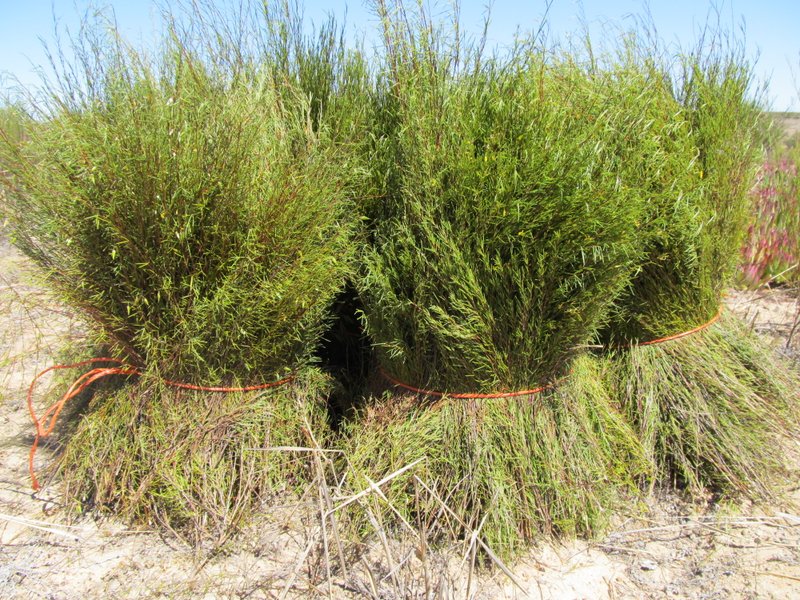 been looking at the conservation benefits of different farming practices. Landuse of all kinds changes the disturbance regimes in an ecosystem and influences the functioning of the ecosystem. For example, ploughing changes the natural soil structure which affects the distribution and persistence of natural species, and sheep passing through an area affects water penetration into the soil and seed dispersal – their hooves compact the soil, and seeds are either eaten and/or transported to other areas. Even the footprints of tourists affect the natural functioning of ecosystems!
been looking at the conservation benefits of different farming practices. Landuse of all kinds changes the disturbance regimes in an ecosystem and influences the functioning of the ecosystem. For example, ploughing changes the natural soil structure which affects the distribution and persistence of natural species, and sheep passing through an area affects water penetration into the soil and seed dispersal – their hooves compact the soil, and seeds are either eaten and/or transported to other areas. Even the footprints of tourists affect the natural functioning of ecosystems!
The people of Nieuwoudtville have long valued their natural environment and the Nieuwoudtville Wild Flower Reserve was created to conserve some of the spectacular and unique local plants. The reserves at the Nieuwoudtville waterfall and Oorlogskloof also protect unique features of the environment. Visitors wanting a memento from the ‘Bulb Capital of the World’ can purchase local bulbs from the Nieuwoudtville Bulb Nursery.
Animals at Nieuwoudtville
 The variety of habitats around Nieuwoudtville has resulted in a gre
The variety of habitats around Nieuwoudtville has resulted in a gre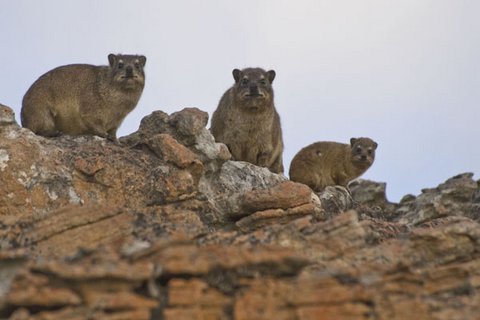 at diversity of small to medium sized animals. Amongst the smallest are the insects, which are always abundant but are never well known. Sixty-three species of ant and nearly 200 species of bees and wasps have been recorded from the area. The harvester ant is one of the more conspicuous insects and can be seen gathering seeds and carting them off to the nest along well worn foraging paths. Ants may also have more subtle interactions such as their relationships with Iycaenid butterflies in which the butterfly larvae are carried into ant nests and tended by worker ants. One such butterfly, Lepidochrysops mcgregori, was described from the farm Glenlyon, (now Hantam National Botanical Garden) south
at diversity of small to medium sized animals. Amongst the smallest are the insects, which are always abundant but are never well known. Sixty-three species of ant and nearly 200 species of bees and wasps have been recorded from the area. The harvester ant is one of the more conspicuous insects and can be seen gathering seeds and carting them off to the nest along well worn foraging paths. Ants may also have more subtle interactions such as their relationships with Iycaenid butterflies in which the butterfly larvae are carried into ant nests and tended by worker ants. One such butterfly, Lepidochrysops mcgregori, was described from the farm Glenlyon, (now Hantam National Botanical Garden) south 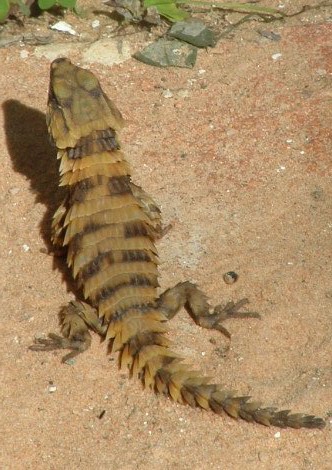 of Nieuwoudtville, in 1968.
of Nieuwoudtville, in 1968.
About 44 species of reptile occur within the Nieuwoudtville area. Rocky parts of the landscape, such as the sandstone, dolerite koppies, and karoo are important habitats for the 24 lizards, 16 snakes and four tortoises that occur here. Renosterveld is generally poor in reptiles due to the absence of rocks and to dense shrub cover. Cultivated lands are also not good for reptiles as the rocks that provide shelter are usually removed during clearing. During surveys of reptiles in the region, only three species (angulate tortoise, karoo sand snake, and spotted sand lizard) were found in Renosterveld and none were found in areas that had been cultivated.
Birds are always an interesting feature of natural and farm environments. The veld around Nieuwoudville would be strangely quiet without the clapping and whistling call of the Clapper Lark or the noisy call of the Black Korhaan. About 200 species of bird are 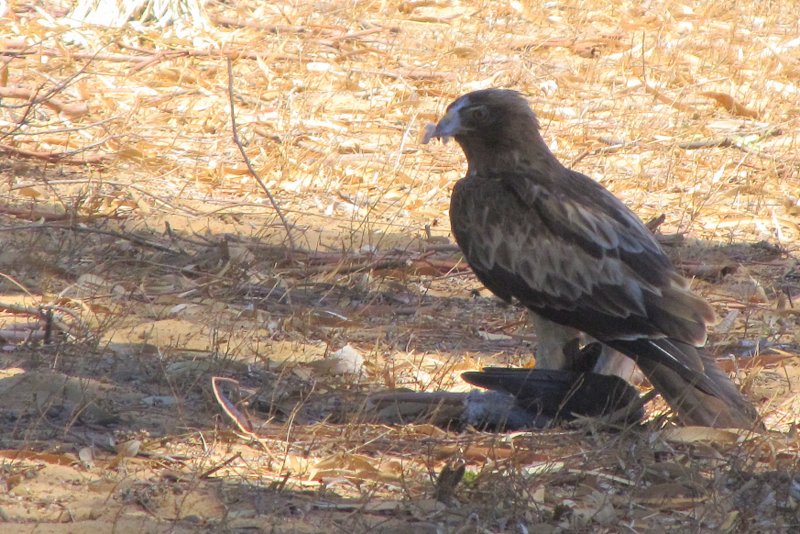 thought to occur in the vicinity. Among them are threatened species such as Blue Crane, Lesser Kestrel, Ludwig’s Bustard, Martial Eagle and near threatened species like Black Harrier.
thought to occur in the vicinity. Among them are threatened species such as Blue Crane, Lesser Kestrel, Ludwig’s Bustard, Martial Eagle and near threatened species like Black Harrier.
Ironically, the Blue Crane does relatively well in wheat growing areas 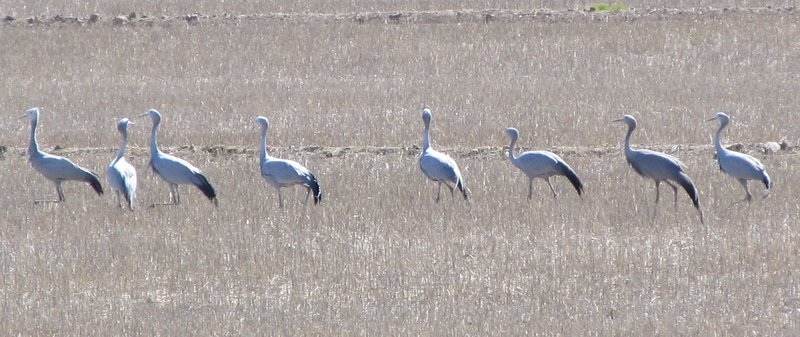 and is most likely to be seen in agricultural lands. Other birds such as Helmeted Guinea Fowl and francolin seem to have declined in intensively farmed areas due to less suitable habitat as well as a possible increase in the abundance of small predators such as mongoose and striped polecat.
and is most likely to be seen in agricultural lands. Other birds such as Helmeted Guinea Fowl and francolin seem to have declined in intensively farmed areas due to less suitable habitat as well as a possible increase in the abundance of small predators such as mongoose and striped polecat.
The aardvark is probably the largest mammal in the area and their diggings for ants and termites leave large holes that are easily seen. Other mammals with a very obvious presence are porcupines, common molerats (their molehills can be seen on the tillite soils), and hairy-footed gerbils that live in colonies with numerous entrance holes. Leopards roam the mountain areas along the escarpment and other mammals in the area include caracal, black-backed jackal, Cape fox, bat-eared fox, Cape clawless otter, striped polecat, baboon, steenbok, and klipspringer. Many species still rely on farmland for their survival, but the Oorlogsklool Nature Reserve is an important refuge in the area.
The unusual fauna of the reserve contains species that are not typically associated with fynbos vegetation and this is due to the presence of other vegetation types in the surrounding farmland.
Soils
The diversity of flowers in Nieuwoudtville is partly explained by the variety of soils. There are five bands of different soils that run parallel to the escarpment (roughly north to south) and the short journey from the top of Vanrhyn’s Pass to a few kilometres past Nieuwoudtville will take you across all the major soil types. At the top of the pass, the soils are derived from Table Mountain Sandstone and these acidic and nutrient poor soils support fynbos vegetation. Although these soils are not generally good for agriculture, they are suitable for the cultivation of rooibos tea, which is a fynbos plant.
A few kilometres east of the escarpment, the sandstone gives way to tillite soils that are derived from Dwyka sediments. The Dwyka rocks were formed when a massive glacier covered the whole Karoo area about 300 million years ago. These soils, known locally as ‘vaalgrond’ have a yellow or grey colour, which is due to chemical changes that occur when the soils become waterlogged during winter. The ‘vaalgrond’ has a high clay content and may form crusts when clay particles move to the surface. Overgrazing and excessive cultivation can promote crust formation and result in greater erosion.
The natural vegetation on these soils is known as renosterveld, but very little remains because most of the land has been ploughed for wheat cultivation. Some of the most interesting soils in South Africa can be seen just east of Nieuwoudtville. The soils are derived from a Karoo dolerite sill, which gave rise to the north-south row of koppies (small rocky hills). The soils are known locally as ‘rooigrond’ (red soil) due to the high iron content, which rusts to give a deep red colour.
The ‘rooigrond’ has a remarkable capacity to shrink and swell during alternate dry and wet periods, giving rise to massive cracks in the soil. The cracks result in a self-mulching process in which topsoil falls into the cracks and subsoil moves to the surface. These soils are called vertisols. They are very fertile but cultivation depletes the soil nutrients. A completely different suite of plants grows on these soils, including many of the Nieuwoudtville endemics.
Beyond the dolerite koppies, the soils are also derived from dolerite, but they have a sandy texture and do not form the deep vertisols found on the west side of koppies. These soils eventually give way to tillite and then soils derived from Ecca Shales, which cover a large proportion of the Karoo.